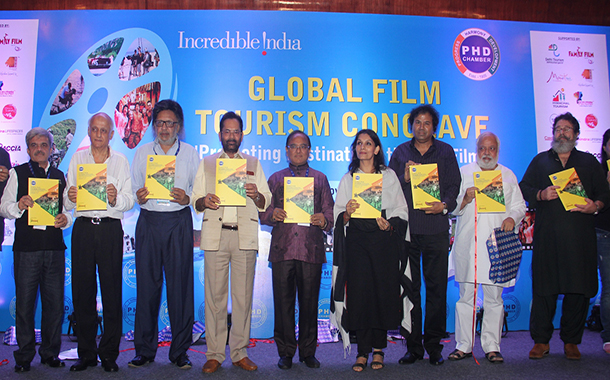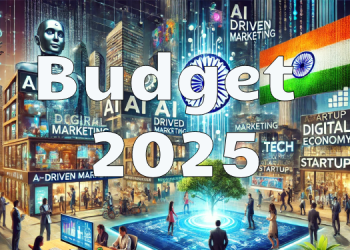Mumbai: The PHD Chamber of Commerce and Industry has projected that the film industry is expected to grow at 11.5% year-on-year, reaching total gross realization of INR 238 billion ($3.7 billion) by 2020 as against its, CAGR of over 10% in the last couple of years.
The aforesaid prognosis has been made jointly by the PHD Chamber and its Knowledge partner BnBNation which has been released today in Mumbai at PHD Chamber Global Film Tourism Conclave ‘Promoting Destinations through Films’ under aegis of PHD Chamber which also focuses that the growth of the industry could be far more higher if its regulations are minimized.
Minister of Minority Affairs Mukhtar Abbas Naqvi, was the chief guest who assured the film industry to bridge in the gap prevailing. The session also witnessed, JaykumarJitendrasinhRawal, Tourism Minister Govt of Maharashtra who spoke in length about the initiatives by Maharashtra Government promoting state tourism. Besides, veterans of the Indian film industry Mukesh Bhatt, Boney Kapoor, N. Chandra and KunalKapoor were among others present at the occasion.
While narrating their experiences of Film Shootings in India, most of the producers demanded to curb the lengthy process of approvals and permissions to shoot. Boney Kapoor stressed upon to create an uniform single window system across India to get the permissions, while Mukesh Bhatt who had shot over 64 bollywood films on international locations told shooting in Indian location is a cumbersome job.
RaduDobre, Ambasador, Romania & ZigmundBertok, Ambassador Slovak Republic,in addition to State tourism boards like Delhi, Himachal Pradesh, Gujarat, and Punjab have given presentations on the incentive schemes for shooting a film in their destinations. International Production Houses like Family Film Entertainment also given presentation on their expertise on film making.
Mukesh Gupta, Chairman-Tourism Committee, PHDCCI, said, “The objective of organizing this conclave was to promote Film Tourism, highlighting the tourism destinations across India and abroad to encourage Indian as well as Foreign Film Makers to shoot films there. As per a survey, Indians top the tourism charts for the number of tourists visiting the famous locations abroad.
Anil Khaitan, Senior Vice President, PHDCCI told films are a great source of showcasing any country’s culture, heritage and vast economic potentials. We are certain that our initiative will surely turn out to be highly fruitful in promoting and creating awareness about the untapped potential of Film Tourism in India, hence we wanted Indian films to portray the same”.
According to the knowledge report, the film industry faces multiple challenges on regulatory fronts such as about 70 approvals and licenses from as many as 30 authorities for shooting films in India.
“Delays in approvals process often results in filmmaker going to other destinations despite cost advantage in the country. Due to hurdles in obtaining licenses, India has lost at least 18 big budget movies toother locations in the last 4 years.Though the Indian film industry is the largest in the world in terms of number of films produced with around 1,500 to 2,000 films produced every year in more than 20 languages. The industry also had the second highest footfalls in the world in 2015 (over 2.1 billion)following China (almost 2.2 billion)”, highlights the report.
“Currently, India is gaining traction as a film shooting destination. After the success of India based moviessuch as Slumdog Millionaire, several internationalstudios are increasingly considering shooting a largeportion of their films in India. India has been usedas a film shooting site for various Hollywood movies such as The Second Best Exotic Marigold Hotel,Million Dollar Arm, The Hundred Foot Journey, Lifeof Pi, Mission Impossible IV and Jobs.Though India boasts of a large number of films and theatre admissions, the Indian film industryis small with respect to other global industries interms of revenue. The gross realization of Indianfilm industry is $2.1 billion versus gross realization of film industry in US and Canada is $11 billion even though they produce only 700 films as opposed to1500+ films produced in India. This is mainly due tolow ticket realizations and occupancy levels, lack of quality content, and rampant piracy. Though Indian film fraternity and government have taken a stand against piracy but Piracy continues to haunt film fraternity with dire consequences. Historically, the film industry in India has grown at a CAGR of over10% in the past”, further emphasis the report.
Elaborating on regulations, the report also indicates that Central clearances, Shooting of foreign feature films in India require the prior approval of the Ministry of Information and Broadcasting(MIB) whereas in case of a documentary,approval of the Ministry of External Affairs(MEA) is required. The script of the film has to be approved by the MIB, which is a time-consuming process; the Ministry may also depute a lia is on officer to facilitate the shooting. Location specific permissions: Film makers require approvals from authorities in specific locations prior to shooting.
The report recommends introduction of Soft Loans: The government should replicate the foreign countries’ film tourism incentives in India. It should provide film makers a short-term loan without charging interest to meet their short-term needs. This would encourage producers to shoot in that particular location, and would catalyse the growth of the industry.Safety & Security: Safety is also a major concern which needs to be address by the government,as increasing terrorist attacks and political disturbance hinder the growth of the industry.
It concludes stating that states should undertake various initiatives likesetting up surveillance cameras, tourist police,24×7 help lines, and compulsory registration oftourist guides operators, etc. to ensure safetyof the tourists as well as the film crew. Theseinitiatives may be highlighted by the states/Central Government in various promotionalcampaigns to project India as a safe and securetourist destination.Investment in Infrastructure: Inadequateinfrastructure acts as the biggest hindranceto the Indian film tourism industry, and hasbeen affecting its growth since past severalyears. Bad road conditions; poor connectivity;inadequate air and sea port capacities; andlack of development of modes of transports,like railways, and alternates, like inland watertransport and domestic aviation, have beencausing delays in the film tourism industryoperations. Due to this, costs per film in the Indianfilm industry increases; and ultimately leads todisturb the planned budget. Therefore, there isan urgent need for investment in infrastructurelinking roads, railways and airports, to curtail thelosses.

















